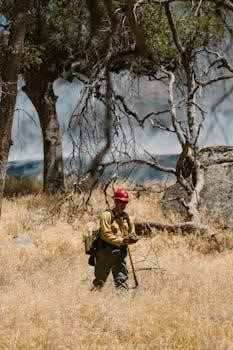nfpa 259 national fire protection association pdf

NFPA 259⁚ Standard Test Method for Potential Heat of Building Materials
NFPA 259 is vital in fire safety, offering a method to measure heat released by materials․ It’s crucial for fire test labs, engineers, and researchers․ This standard helps assess building materials’ flammability, ensuring structures can withstand extreme heat․ Stay informed about NFPA 259’s development․
Overview of NFPA 259

NFPA 259, the Standard Test Method for Potential Heat of Building Materials, is a crucial standard published by the National Fire Protection Association (NFPA)․ This standard provides a laboratory method to determine the potential heat of building materials exposed to high temperatures․ It is essential for evaluating fire hazards in construction․ The test method yields a property-type measurement․
This standard is widely used by fire test laboratories, manufacturers, fire protection engineers, and fire researchers․ NFPA 259 helps ensure building materials meet safety requirements․ It aids in protecting lives and property from fire․ The standard has been updated over the years to reflect new research and best practices․ The latest editions incorporate technical updates and editorial revisions․
NFPA 259 assesses the potential heat value of materials․ Materials must not exceed specified limits, like 8141 kJ/kg (3500 Btu/lb)․ This standard is integral to construction safety․ It helps engineers and construction crews create safer structures․ Flammability testing is vital for ensuring products can withstand extreme conditions․ NFPA 259 helps maintain safety․
Purpose of NFPA 259
The primary purpose of NFPA 259 is to establish a standardized laboratory test method for determining the potential heat of building materials․ This test helps to quantify the amount of heat that a material can release under specific, controlled conditions․ This information is critical for assessing the fire hazard associated with the use of these materials in buildings and other structures․
By providing a consistent and reliable method for measuring potential heat, NFPA 259 enables fire protection engineers, building designers, and regulatory authorities to make informed decisions about material selection․ The test results can be used to evaluate whether a material meets code requirements for flame spread and heat release․
NFPA 259 also aims to provide a means of comparing the potential heat of different building materials․ This allows for a more objective assessment of the relative fire risk associated with each material․ The data obtained from this test can be used to support fire risk assessments, performance-based design, and other fire safety engineering analyses․ Ultimately, the purpose of NFPA 259 is to enhance fire safety in buildings by providing reliable data on the potential heat of building materials․
Scope of the Standard
The scope of NFPA 259, Standard Test Method for Potential Heat of Building Materials, clearly defines what the standard covers and what it does not․ It explicitly states that this test method provides a means of determining, under controlled laboratory conditions, the potential heat of building materials when subjected to a defined high-temperature exposure․ This means the standard focuses on quantifying the total heat energy a material can release when burned completely․
The standard applies to a wide range of building materials used in construction, including but not limited to, wall coverings, insulation, flooring, and structural components․ The scope includes the preparation of samples, the calibration of equipment, and the procedures for conducting the test․ It specifies the apparatus required, including the oxygen bomb calorimeter, and outlines the steps for measuring the heat released during combustion․
However, it’s important to note what NFPA 259 does not cover․ It does not address the rate at which heat is released, only the total potential heat․ It does not provide information on flame spread, smoke generation, or other fire performance characteristics․
Editions and Updates of NFPA 259
NFPA 259, like all NFPA standards, undergoes periodic review and updates to reflect advancements in knowledge, technology, and best practices․ These revisions ensure the standard remains relevant and effective in addressing fire safety concerns related to building materials․
The 2003 edition incorporated requirements from the Manual of Style for NFPA Technical Committee Documents, focusing on clarity and consistency․ The 2008 edition was a reaffirmation of the 2003 edition, indicating no significant changes were deemed necessary at that time․ The 2013 edition introduced a new test limitation, revised oxygen bomb calorimeter requirements, and revised annex material, reflecting improvements in testing methodologies․
The 2018 edition of NFPA 259 is currently active․ The 2023 edition is the most recent version․ These updates often include clarifications, corrections, and enhancements to improve the accuracy and reproducibility of the test method․ Staying current with the latest edition of NFPA 259 is crucial for fire test labs, manufacturers, and fire protection engineers to ensure they are using the most up-to-date and reliable methods for assessing the potential heat of building materials․
NFPA 259 (2018 Edition)
The 2018 edition of NFPA 259⁚ Standard Test Method for Potential Heat of Building Materials provided a crucial test for determining the potential heat of materials․ It offers a test method to determine the potential heat of building materials under controlled conditions․ This edition is essential for fire test labs, manufacturers, fire protection engineers, and fire researchers․
It focuses on measuring the amount of heat released when subjected to a defined high-temperature exposure․ It provides a property-type measurement, critical for understanding how materials contribute to fire intensity․ It aids engineers in selecting safer materials to mitigate fire risks․
The 2018 edition is a valuable resource for assessing the flammability of construction materials․ It helps ensure that buildings are constructed with safety in mind․ The standard is an important tool in fire protection․ It uses controlled lab tests to determine the potential heat released․ This helps protect property from potential fire hazards․
NFPA 259 (2023 Edition)
The 2023 edition of NFPA 259 continues to provide a vital means for determining the potential heat of building materials under controlled lab conditions․ This latest edition remains a must-have for fire test laboratories, manufacturers, fire protection engineers, and fire researchers․ It helps determine the amount of heat released by building materials when exposed to a heat source․
The standard offers a property-type measurement to ensure building safety․ It is essential for understanding material contributions to fire hazards․ The 2023 edition incorporates updates to reflect current testing practices․ Stay informed about the standards development process for NFPA 259 to ensure you are using the most current methods․
An errata has been issued for the 2023 edition, so be sure to check for any corrections․ This edition provides critical information for engineers and construction crews․ Flammability testing is crucial for safety․ NFPA 259 helps ensure products withstand extreme circumstances․ It assists in minimizing risks associated with building material flammability, making it essential․
Test Method Description
NFPA 259 outlines a precise laboratory method for determining the potential heat of building materials․ The test method involves exposing materials to defined high-temperature conditions․ The procedure aims to quantify the amount of heat a material can release when subjected to fire․ The test is conducted under strict, controlled conditions to ensure accuracy and repeatability․
The process involves using an oxygen bomb calorimeter to measure the heat released during combustion․ Samples are carefully prepared and placed within the calorimeter․ The calorimeter is then sealed and pressurized with oxygen․ The sample is ignited, and the heat released from the combustion process is measured․ This measurement provides the potential heat value of the building material․
The test method is critical for assessing the fire risk associated with different building materials․ The results help engineers select materials that minimize fire hazards; NFPA 259 provides a standardized approach to flammability testing․ The standard specifies detailed requirements for equipment, sample preparation, and data analysis․ This ensures consistent and reliable results across different testing laboratories․
Determining Potential Heat of Building Materials
Determining the potential heat of building materials using NFPA 259 involves a controlled laboratory procedure․ The process quantifies the heat released by a material when exposed to high temperatures․ This measurement is crucial for evaluating the fire risk associated with the material․ The standard dictates the use of an oxygen bomb calorimeter for accurate measurement․
The material sample is prepared according to NFPA 259 guidelines․ The prepared sample is placed inside the oxygen bomb calorimeter․ The calorimeter is then sealed and pressurized with oxygen to create an environment that supports combustion․ The sample is ignited, and the calorimeter measures the total heat released during the burning process․
The data collected from the calorimeter provides the potential heat value of the building material․ This value is expressed in units such as kJ/kg or Btu/lb․ The potential heat value helps engineers and construction professionals select appropriate materials․ Materials with lower potential heat values contribute less to fire intensity․ This process aids in designing safer and more fire-resistant structures․ Accurate determination of potential heat is vital for fire safety․
Application of NFPA 259 in Construction
NFPA 259 plays a crucial role in construction by providing a standardized method for assessing the fire potential of building materials․ This standard guides architects, engineers, and construction crews in selecting materials that minimize fire hazards․ By adhering to NFPA 259, structures can be designed to better withstand fire and protect occupants․
The application of NFPA 259 helps ensure that materials used in construction meet specific fire safety requirements․ These requirements are often incorporated into building codes and regulations․ Compliance with NFPA 259 is essential for obtaining building permits and ensuring the safety of the built environment․

Furthermore, NFPA 259 testing data informs decisions about fire suppression systems and emergency response plans․ Understanding the potential heat of building materials allows for more effective fire protection strategies․ It helps in designing structures that limit fire spread and provide occupants with more time to evacuate safely․ Therefore, NFPA 259 significantly enhances fire safety in construction․
Significance of Flammability Testing
Flammability testing is of paramount importance in ensuring the safety of buildings and their occupants․ NFPA 259 provides a standardized approach to flammability testing, determining how building materials react to heat․ This testing is vital for fire protection engineers, manufacturers, and construction crews, aiding in the selection of appropriate materials․
The data obtained from flammability testing, as per NFPA 259, is used to predict the potential fire hazards associated with different building materials․ This information is then used to develop fire safety strategies, including the design of fire suppression systems and evacuation plans․ Understanding the flammability characteristics of materials helps minimize the risk of fire spread and maximize the time available for occupants to escape․
Furthermore, flammability testing contributes to compliance with building codes and regulations․ Many jurisdictions require that building materials meet specific flammability standards․ Therefore, flammability testing is essential for obtaining building permits and ensuring that structures meet the necessary safety requirements․ In essence, flammability testing is a cornerstone of fire safety in the construction industry․
Materials Subject to NFPA 259 Testing
NFPA 259 is applicable to a wide array of building materials, encompassing those used in both structural and decorative applications․ These materials can range from traditional wood products and drywall to modern composites and plastics․ The standard is designed to assess the potential heat release of these materials when exposed to a defined high-temperature environment․
Specifically, materials like insulation, wall coverings, flooring, and roofing components are frequently subjected to NFPA 259 testing․ The test method is also used to evaluate the flammability of materials used in furniture and furnishings, ensuring that they meet fire safety requirements․ Moreover, the standard can be applied to materials used in specialized applications, such as those found in fire-resistant doors and walls․

It is important to note that the form in which a material is used can significantly impact its flammability characteristics․ Therefore, NFPA 259 testing is typically conducted on materials in their final form, as they would be installed in a building․ This ensures that the test results accurately reflect the material’s behavior under real-world conditions․
Where to Purchase the NFPA 259 PDF
The official NFPA 259 document, in PDF format, is primarily available for purchase through the National Fire Protection Association (NFPA) itself․ The NFPA website is the most reliable source to acquire the standard, ensuring you receive the correct and most up-to-date version․
Additionally, authorized distributors and resellers of NFPA publications may offer the NFPA 259 PDF for purchase․ These distributors are often listed on the NFPA website or can be found through online searches․ When purchasing from a reseller, verify their accreditation to ensure authenticity․
Be cautious of obtaining the NFPA 259 PDF from unauthorized sources, as these may provide outdated, incomplete, or even counterfeit versions of the standard․ These unofficial copies can lead to inaccurate testing and potentially compromise fire safety measures․
The cost of the NFPA 259 PDF can vary, so it’s advisable to check the NFPA website or authorized distributors for current pricing․ Consider purchasing directly from NFPA to support their mission of fire safety․
Participation in the NFPA 259 Standards Development Process

Engaging in the NFPA 259 standards development process is vital for ensuring the standard remains current and effective․ NFPA encourages participation from various stakeholders, including fire protection engineers, manufacturers, researchers, and members of the public․
One way to participate is by joining the Technical Committee on Fire Tests, which is responsible for developing and maintaining NFPA 259․ Committee members contribute their expertise and insights to improve the standard․
Another avenue for participation is by submitting public inputs during the revision cycle of NFPA 259․ Public inputs are suggestions for changes or additions to the standard․ These inputs are carefully considered by the Technical Committee․
NFPA also provides opportunities to comment on proposed changes to NFPA 259 during the public comment period․ This allows stakeholders to express their views on the proposed revisions․
By participating in the NFPA 259 standards development process, you can contribute to enhancing fire safety in the built environment․ Your involvement helps ensure that the standard reflects the latest knowledge and best practices․




